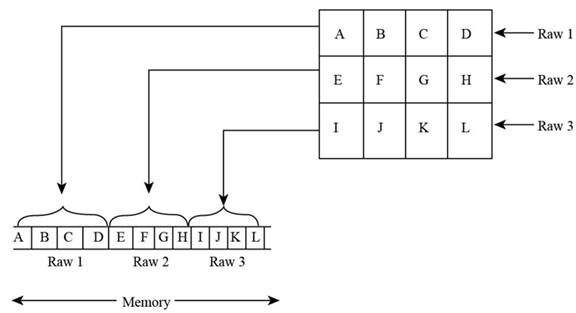
Concept explainers
Row major order:
In the method of Row major order, the array is stored in memory by arranging sequentially row by row. The element of first row of array stores into the first set of memory location and second row into second set of memory location and so on.
Column major order:
In this method, elements of array are stored in the memory by arranging sequentially column by column. The element of first column is stored into consecutive memory location and this process continues for all the columns.
Explanation of Solution
Draw pictures of storing the array in memory’s location by row major order:
There are three rows in the given array. The row 1 is ABCD which is stored in the first set of memory’s location. The row 2 is EFGH which is stored in the second set of memory’s location and row 3 which is IJKL, stores in the third set of memory’s location.
This process is shown in below:

Draw pictures of storing the array in memory’s location by row major order:
There are four columns in the given array. The column 1 which is AEI is stored into first set of memory’s location. The column 2 which is BFJ is stored into second set of memory’s location and the column 3 and column 4 which are CGK and DHL respectively are stored into third and fourth set of memory’s location.
This process can be shown in below:

Want to see more full solutions like this?
Chapter 8 Solutions
Computer Science: An Overview (13th Edition) (What's New in Computer Science)
 EBK JAVA PROGRAMMINGComputer ScienceISBN:9781337671385Author:FARRELLPublisher:CENGAGE LEARNING - CONSIGNMENT
EBK JAVA PROGRAMMINGComputer ScienceISBN:9781337671385Author:FARRELLPublisher:CENGAGE LEARNING - CONSIGNMENT Systems ArchitectureComputer ScienceISBN:9781305080195Author:Stephen D. BurdPublisher:Cengage Learning
Systems ArchitectureComputer ScienceISBN:9781305080195Author:Stephen D. BurdPublisher:Cengage Learning C++ for Engineers and ScientistsComputer ScienceISBN:9781133187844Author:Bronson, Gary J.Publisher:Course Technology Ptr
C++ for Engineers and ScientistsComputer ScienceISBN:9781133187844Author:Bronson, Gary J.Publisher:Course Technology Ptr New Perspectives on HTML5, CSS3, and JavaScriptComputer ScienceISBN:9781305503922Author:Patrick M. CareyPublisher:Cengage Learning
New Perspectives on HTML5, CSS3, and JavaScriptComputer ScienceISBN:9781305503922Author:Patrick M. CareyPublisher:Cengage Learning Microsoft Visual C#Computer ScienceISBN:9781337102100Author:Joyce, Farrell.Publisher:Cengage Learning,Programming Logic & Design ComprehensiveComputer ScienceISBN:9781337669405Author:FARRELLPublisher:Cengage
Microsoft Visual C#Computer ScienceISBN:9781337102100Author:Joyce, Farrell.Publisher:Cengage Learning,Programming Logic & Design ComprehensiveComputer ScienceISBN:9781337669405Author:FARRELLPublisher:Cengage





